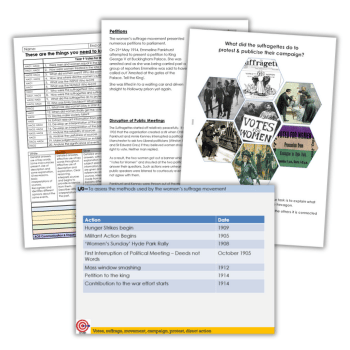Worksheets, PowerPoint, information sheets
KS3
Years 7-9
This Suffrage movement download includes facts and statistics on pay, hours worked and career progression, as well as news articles, photos and other similar sources.
Start your topic about the suffrage movement by looking at the present day. Discuss the current role of women before exploring these resources and asking students to consider this question: Today, are men and women equal?
By exploring this question, students will initiate ideas of inequality and disparities between the sexes, which takes us nicely into what lives were like in the past.
- Learning matrix
- Hexagon activity – protesting and publicising
- Information sheets
- PowerPoint – use alongside hexagon activity
- Marketplace worksheet
Why we must teach the Women’s Suffrage Movement
Teaching young people about the battles fought by previous generations for rights we take for granted today can help them develop as historians – and humans, insists Victoria Hewett…
As a 30-year-old woman, I feel ashamed to say I didn’t truly begin to understand the enormity of the suffrage movement until my mid-20s.
I’m disappointed that I was never taught about women’s fight for the vote during my secondary education and I’m embarrassed that I knew so little about such a poignant part of modern history until adulthood.
Despite the lack of historical knowledge, since the age of 18 I’ve made the effort to vote at every opportunity.
As a geographer, I recognised that it was a right that was fought for; that there were still societies around the world that don’t have fair democratic rights and that there are those still fighting for the opportunity to cast a vote.
Historically though, I’d been naïve. I first became aware of the scale of the women’s suffrage movement when I had to teach ‘the changing role of women’ as part of the GCSE history course I found myself delivering in my third year in the profession.
More depth
Women’s suffrage was just a small part of the syllabus, but what I realised was that this was a topic that needed more depth, more exploration and more understanding.
After that, I decided that when I created the Year 9 curriculum for the following September, women’s suffrage was going to be a part of it.
The first set of students to go through Year 9 found the topic intriguing and enlightening. They too had little understanding of the suffrage movement – and more so, there was a lack of understanding of the distinct disparities between the lives of men and women in the past and present.
As soon as I started teaching the topic, I could see it had been the right choice.
Why suffrage?
The role of women in the home, workplace and society has vastly changed since the 19th century but young people (as well as adults) are not fully aware of the hardships women have had to endure to reach our current position.
So why should we teach students about this? First, I believe it’s vital for pupils to understand that life hasn’t always been this way here in the UK. Previous generations have experienced hardships beyond our imaginations and have fought for choice, rights and freedoms that many of us take for granted today.
Therefore, teaching young people to be passionate about using their voice and their vote proactively is important. Helping them to understand that it’s an opportunity and liberty that shouldn’t be taken for granted or wasted as there are still those in the world without the right to vote or ability to speak up on issues that matter.
Teaching about the suffrage movement builds empathy; helping students to understand the passion and fury felt by women of the later 19th and early 20th centuries, as well as those involved in anti-suffrage campaigns.
It requires learners to empathise with their emotions and their experiences to truly understand the positions of those in the past.
Additionally, it develops tolerance and an understanding of feminism; learning that it’s about equality in the political, social and economic spheres.
Skills and substance
I’ve found that teaching this topic is a great one for developing and embedding resource skills such as interpretation of primary and secondary sources, analysing the reliability and usefulness of sources as well as judging the significance of events. It ticks so many boxes.
After teaching the topic for the first time, I saw how it had opened up the minds of my students. The reality of what women (and men) went through to achieve the vote was understood.
My students became more engaged with the political sphere and discussions developed around the political parties and what they stood for.
Since then I’ve moved back to teaching just geography, but my passion for the women’s suffrage movement hasn’t faltered. I continue to research the topic and partake in a suffrage living history group.
More poignantly, I often make reference to the role of women and the suffrage movement in my lessons; there are so many links to development, demographics and geo-politics of more recent times.
Victoria Hewett is the subject leader for geography at a secondary school in Kent and the teacher behind MrsHumanities. Find out more about her suffrage scheme of work. Browse more resources for International Women’s Day.














